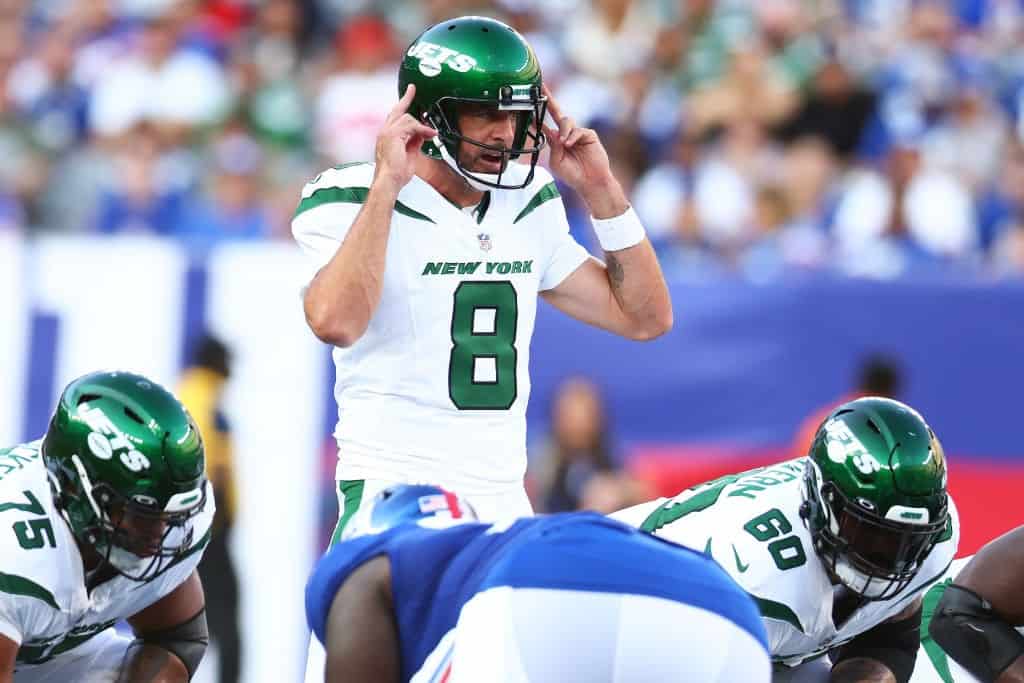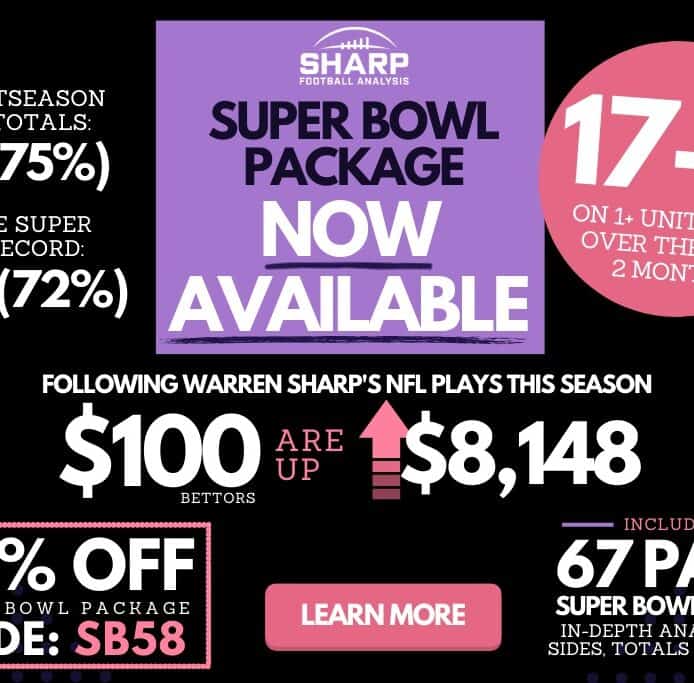- Understanding the NFL starts with a simple question: what truly wins games?
- The goal must be to navigate the fastest path to victory each week based on your strengths and your opponent’s weaknesses.
- Great offenses will beat great defenses because the rules so heavily favor the offense.
- Continue reading to learn what Warren Sharp thinks you should know before betting on the NFL this season.
10 things you need to know before you watch & bet on the NFL:
1. Down Set Conversion Rate
Get familiar with the metric Down Set Conversion Rate (DSC%). It measures the percentage of first downs that get converted into another first down. In other words, how often are you moving the chains on offense?
How does it work? Take the first drive of the season for the Buccaneers last year:
- 1st & 10: 5-yard penalty, no play
- 1st & 15: 24-yard gain (new 1st down)
- 1st & 10: 2-yard gain
- 2nd & 8: 20-yard gain (new 1st down)
- 1st & 10: 7-yard gain
- 2nd & 3: 2-yard gain
- 3rd & 1: -1 yard gain
- 4th & 2: field goal
That drive featured three first downs that could have been converted (the penalty is not a play), and the Bucs converted two of the three. That’s a DSC of 67% (2/3).
A drive with a TD will have a 100% DSC.
A three-and-out will have a 0% DSC.
A first half that featured three drives without a single first down followed by a drive with one first down gained and then a punt would have a DSC of 20% (1/5).
Why should you care?
The relationship between offensive DSC% and a team’s ability to cover the spread is much stronger than most metrics.
Naturally point margin is the strongest followed by points scored. But DSC% is way up there.
The 10 best teams in DSC% offensively last year were the:
- Chiefs
- Eagles
- Bills
- Lions
- Bengals
- 49ers
- Jaguars
- Packers
- Raiders
- Cowboys
The 10 worst teams in DSC% offensively last year were the:
- Commanders
- Rams
- Bears
- Patriots
- Colts
- Panthers
- Titans
- Broncos
- Jets
- Texans
It’s an excellent metric when examining teams that potentially recorded “unearned” wins and that might be solid fades the following week. And it is especially valuable early in the season.
Where can you find this metric each week? I’ll be covering it in my articles every single Monday and sending it out to the mailing list, so subscribe to get YTD stats and weekly updates on the Down Set Conversion Rate!
2. Strength of Schedule Matters
- 6 of the 7 teams with the easiest schedules in 2022 went to the playoffs
- 2 of the 7 teams with the hardest schedules in 2022 went to the playoffs
Trying to exceed and overachieve against a brutal schedule rarely happens (two out of the top seven in 2022). Likewise, winning against an easy schedule and overachieving compared to expectation was quite regular (only one out of the top seven did not).
My strength of schedule model is a living, breathing organism. Since it is based on forecasted win totals, it is constantly changing as the betting market changes.
I just updated my strength of schedule model: NFL Strength of Schedule for 2023.
Teams whose schedules are slightly easier now as compared to May:
- Giants
- 49ers
- Seahawks
- Cowboys
- Broncos
- Eagles
- Chiefs
Teams whose schedules are slightly harder now as compared to May:
- Jaguars
- Panthers
- Titans
- Bucs
- Texans
- Lions
It’s important to know which teams are predicted to face difficult schedules because such teams infrequently exceed expectations.
Last year, of the 10 teams predicted to have the hardest 2022 schedules, only two went to the playoffs (Bengals, Chiefs).
The 10 teams with the toughest 2023 schedules?
- Patriots (hardest)
- Raiders
- Dolphins
- Chargers
- Chiefs
- Vikings
- Bills
- Jets
- Commanders
- Buccaneers
When we look at those teams in the AFC, it’s nearly impossible to believe the Chiefs, Bills, Jets, Chargers, and Dolphins will have trouble making the playoffs. But their forecasted schedules are brutal. And there could be some surprise absences if things don’t fall perfectly for these teams.
The 10 teams with the easiest 2023 schedules?
- Falcons (easiest)
- Saints
- Colts
- 49ers
- Panthers
- Bears
- Steelers
- Seahawks
- Texans
- Eagles
While schedule is important to consider here at the start of the season, it is also vital to consider the schedule during the early part of the season and update strength of schedule if you are trying to get a better understanding of future schedule strength.
Don’t miss out on the biggest value we have to offer this NFL season!
Leveraging Warren Sharp’s 17-year betting record, our All-Access package includes NFL & NCAAF betting, Player Props & in-season Fantasy Football products.
This package also includes Warren’s NFL computer totals, which have gone 60-20 (75%) over the last two years and is 62.3% lifetime.
Use code SAVE25 for 25% OFF all our packages, sitewide.
3. Forecasting Year-Over-Year Improvement Can Pay Off Massively
Let’s hit red zone production and then hit explosion.
The 7 teams I think will improve inside the red zone most in 2023:
- Baltimore Ravens – #27 inside the red zone, #17 outside the red zone
- Green Bay Packers – #26 inside the red zone, #11 outside the red zone
- Atlanta Falcons – #17 inside the red zone, #10 outside the red zone
- Jacksonville Jaguars – #21 inside the red zone, #7 outside the red zone
- Cleveland Browns – #20 inside the red zone, #14 outside the red zone
- Seattle Seahawks – #25 inside the red zone, #12 outside the red zone
- San Francisco 49ers – #18 inside the red zone, #4 outside the red zone
Did you know that last year, Deshaun Watson completed just 8% of his passes that were thrown into the end zone? That was the worst red zone completion rate for any NFL QB with over 12 attempts IN THE LAST DECADE! There’s very little chance this doesn’t regress.
Seattle ranked 30th in play success rate inside the red zone and tried to run too often despite ranking a terrible #31 in rushing success.
I’d expect them to pass more frequently inside the red zone with their new receiver weapons and generate more efficiency from these attempts.
DK Metcalf led the NFL with 22 end zone targets in the red zone. The next closest player had 14. But just five were scores (22.7%) after posting conversion rates of 33.3%, 42.9%, and 46.7% on his end zone targets before last season.
Inside the red zone last year the Ravens ranked:
- #28 in EPA/play
- #30 in touchdown rate (46% vs. an NFL average of 56%)
Even with Lamar Jackson through Week 13, they ranked #23 in touchdown rate.
They were also bottom 10 in goal-to-go efficiency.
None of this is commensurate with the offense over the rest of the field last year, which ranked fringe top 10 with Jackson.
In fact, over the course of the entire season, the Ravens drove into the red zone at the #5 highest rate of any team but simply could not buy a touchdown when there (#30).
There is no reason a top-five offense at driving into the red zone should rank #30 in scoring touchdowns when down there.
Baltimore scored touchdowns on just 29% of drives that crossed midfield. That was sixth worst in the NFL. And they ranked 28th in third down conversion rate in the red zone.
There is no doubt the play designs and calls with Greg Roman at the helm were getting too stale and predictable in the red zone.
I believe with Todd Monken’s new offensive direction, the 2023 Ravens will be scoring in the red zone at a rate more in line with their overall offensive efficiency.
Inside the red zone last year the Packers ranked:
- #25 in EPA/play in the red zone
- #24 in TD rate inside the red zone
- #32 in goal-to-go efficiency (50% vs. an NFL average of 72%)
But look at where the Packers ranked as a whole in 2022:
- #16 in EPA/play
- #14 in success rate
- #8 in early down success rate
The offense is good enough. This is coaching.
This is on Matt LaFleur to get his best plays in the game, adjust for what the defense is trying to take away, and produce points consistent with the team’s overall efficiency between the 20s.
Can he do it in 2023?
I’m fairly confident he has the ability.
If you look at 2020 and 2021 combined, the offense ranked #3 in both red zone efficiency AND goal-to-go efficiency.
It will be even more critical LaFleur is prepared to get his best calls in with a new quarterback. There may be more errors, making it even more important to capitalize when the opportunity presents itself.
Additionally, I think we will see Jordan Love scramble more in the red zone.
Last year, Aaron Rodgers dropped back to pass in the red zone 82 times, ninth most in the NFL.
Yet he scrambled on just three of those dropbacks. That 3.7% was well below the NFL average. And was well below Rodgers' past scramble rate, which was 7.8%, 7.8%, 5.0%, and 9.7% in his first 4 years as an NFL starter.
In addition, Rodgers averaged -0.11 EPA/scramble in the red zone, by far the worst in his career.
QB scrambles in the red zone are generally +EV plays. In fact, for Rodgers between 2016 and 2021, his EPA/scramble was +0.18. I expect Love to scramble much more than 3.7% of his red zone dropbacks and to earn much more than -0.11 EPA/scramble.
4. Correctly Forecasting Increased Explosion Is Likely to Pay Off in a Major Way
Drives are over 10 times more likely to score a touchdown with just one play of 15 or more yards.
Why else does it matter? Look at last year.
Teams that had an edge of two or more explosive plays in an entire game won 67% of those games (174 game sample) and covered the spread in 55.2% of those games.

















